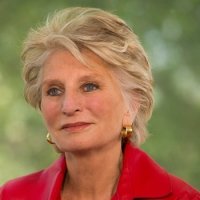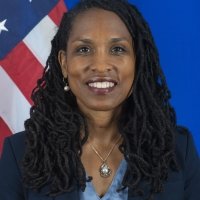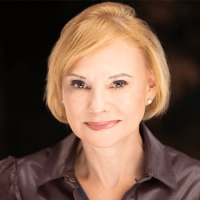At the Eye of the Storm: Women and Climate Change
Struggling to save their failing crops. Walking farther afield to fetch clean water. Protecting their families from devastating storms and violent conflicts. “Women are usually the support systems for our family…we are the last to leave in the event of a catastrophe, which is why women and families are disproportionately hurt by climate catastrophes,” said Wilson Center President, Director, and CEO Jane Harman on June 23 during a conference on women and climate change.
But empowering women through education, economic opportunities, and reproductive health care can also make powerful contributions to climate resilience. “Who should be the leaders in the climate change policy debate? I would say women,” said Harman. “I think we have the best experience and adequate training in every respect to lead on the climate change arguments.”
Climate change is a “threat multiplier,” said Sherri Goodman, a public policy fellow at the Wilson Center and former deputy undersecretary of defense for environmental security, and “resilience…is the answer to addressing the climate challenge.”
Our Bodies, Our Planet
The connection between family planning and climate change is not immediately obvious, but Suzanne Ehlers, executive director of the advocacy organization PAI, said access to contraceptives is arguably “the answer.” Climate change requires “inclusive and comprehensive community action” and family planning ensures that “half of the world’s population can productively and meaningfully engage in the pressing issues of our time.”
Clive Mutunga, a PHE technical advisor for the Office of Population and Reproductive Health at the U.S. Agency for International Development, recounted the story of Samiyathu, a 16-year-old girl living near Malawi’s Lake Chilwa. Samiyathu’s stepfather worked as a fish trader and her mother relied on the water from the lake for her crops. When Lake Chilwa partially dried up in 2012, the devastating effects rippled throughout the community.
“Creating a gendered response to climate change impacts actually offers the most opportunity to increase resiliency”
Amidst the desolation of the drought, Samiyathu’s family heard rumors that she had a boyfriend. Fearing that she might get pregnant, they quickly married her to a 45-year-old man, who was already married to another woman, in exchange for a large bride price. The economic suffering driven by the drought pushed the family to resort to desperate means – at Samiyathu’s expense.
Unlike many girls, Samiyathu was able to escape the arranged marriage. A local radio station broadcast her story, and her parents received pleas from health and development officials. The marriage was called off. Later, she received a scholarship to attend school and was able to pursue her dreams of becoming a nurse.
“Investing in family planning and reproductive health care is one of the ways that [we] can help families, individuals, and communities to better adapt to the effects of climate change,” Mutunga said. Spacing, delaying, or preventing pregnancy helps women and girls stay in school, pursue paid work, and adapt to changing conditions more easily.
Providing reproductive health care and information to women increases their options, said Sono Aibe, senior advisor for strategic initiatives at the NGO Pathfinder International. “When people understand the choices they make every day have consequences for the long-term – for the future – and if solutions for their problems were presented in such a way [that] they understand it and they also can act upon them, they will definitely use these solutions to try and improve their situation, no matter where you are.”
As examples of some of these solutions, Aibe pointed to integrated population, health, and environment (PHE) projects by Pathfinder International that combine environmental interventions like improving fisheries management, introducing energy-saving technologies, and supporting more eco-friendly livelihoods with efforts to improve health systems and train community health workers.
Women in Crises
Swathi Veeravalli, a research scientist at the Army Corps of Engineers, stressed that when normal social rules break down – as sometimes happens during disasters or violent conflict – women face unique risks. “Women and girls are frequently subjected to intimidation, gender-based violence, sexual harassment, and rape” during these crises, said Veeravalli.
Women are often the primary caretakers in a family, making it more challenging to escape from a disaster. Afterwards, caretakers may find it harder to return to the workforce or education if their children suffer long-term effects from the crisis. Jacqueline Patterson, director of the NAACP’s Environmental and Climate Justice Program, pointed out this challenge is facing women in Flint, Michigan, where lead poisoning may have caused permanent brain damage in some children.
Patterson also warned about the possible harm from recovery efforts or disaster assistance programs that are not inclusive. “Certain communities end up worse” if the system fails to accommodate the needs of the community, she said, and how can it do so when half the population has a muted voice?
A 20-point plan created through a “100 percent women-led process” was developed in the aftermath of the Flint crisis, said Patterson. “If that 20-point plan would have been in place the crisis would have never happened in the first place.”
Kelly Fish, a technical advisor at the development non-profit Project Concern International, called for more “simple acts,” such as planting trees, engaging with neighbors, and organizing women’s saving groups in order to adapt to the effects of climate change. She argued these actions can have a profound impact at a very micro level by positively impacting “women’s economic empowerment, agency, and voice.”
Focusing on simple acts is powerful because encourages often marginalized voices to be a part of the conversation, building resilience by increasing social capital. “Creating a gendered response to climate change impacts actually offers the most opportunity to increase resiliency and agency and perhaps decrease vulnerability,” said Veeravalli.
Climate Champions
“Women are more than half of the world’s population, but many do not receive support for their environmental leadership and that leadership is unique, innovative, and often comes at great risk,” said Maxine Burkett, a Wilson Center fellow, law professor at the University of Hawaii, and vice chair of the board of the Global Greengrants Fund. “Less than 0.01 percent of worldwide private grants fund projects at the intersection of women and climate change,” she said.
Some of the efforts underway to change this were described by Matthew Edwardsen, director of the environment and natural resources at the consulting and engineering firm Tetra Tech, and Neha Misra, chief collaboration officer at the energy and women’s empowerment non-profit Solar Sister.
Tetra Tech’s climate vulnerability assessment program evaluates a community’s exposure and sensitivity to the effects of climate change by looking at its capacity to improve resilience. Supporting women entrepreneurs so “they can buy food, they can pay for education, they can really be self-empowered” is a key way to increase a community’s ability to adapt, said Edwardsen.
“Less than 0.01% of worldwide private grants fund projects at the intersection of women and climate change”
Solar Sister has recruited and trained more than 2,500 women to be clean energy entrepreneurs across sub-Saharan Africa, said Misra. These women bring clean energy and “trusted customer care” to their neighbors through the sale and distribution of solar lights and clean cookstoves.
Women in the small rural communities where these entrepreneurs work often do not know the concepts used to describe climate change, but “they experience it…they know what is happening,” said Misra. “Solar Sister’s model is empowering women, increasing women’s income, and making communities safer.”
Clean cookstoves are another intervention that targets the nexus of energy, climate change, and gender. Stevie Valdez, manager of impact investing and market development at the Global Alliance for Clean Cookstoves, highlighted the devastating impacts of “dirty cooking.” Three billion people – 40 percent of the world’s population – are affected by indoor air pollution, which causes pneumonia, stroke, heart disease, chronic obstructive pulmonary disease, and lung cancer; 4.2 million of them die each year, more than from AIDS, malaria, and tuberculosis combined.
Clean cookstoves can reduce the harmful smoke produced by cooking, as well as the amount of fuel needed and time spent cooking. Such small changes can add up. “Up to one third of ambient air pollution in South and East Asia…comes from the household,” said Valdez, and “25 percent of black carbon emissions globally come from the household-level use of solid fuels.”
Valdez shared the story of Lucy, who purchased a clean cookstove from a friend and now saves approximately $200 a year on charcoal. Evidence suggests that women use the money saved from projects like this to improve the health, education, and economic status of themselves and their families. And women have proven to be successful salespeople for clean energy. A study from Johns Hopkins University found that when women cookstove entrepreneurs were given “agency-based empowerment training,” they outsold their male counterparts three times to one and their customers reported greater satisfaction.
“Women are not just the eye of the storm,” said Richard Parker, vice president of marketing and communications for Project Concern International, “but I think they’re also leading us out of that storm…with a steady commitment to their families and communities and navigating climate change in their countries.”
Overcoming the systematic ways in which women have been marginalized is a long-term project, requiring commitment by and collaboration between development practitioners, governments, communities, and civil society. The storm that is global climate change is only just beginning and its effects will continue for decades.
For more, follow our “At the Eye of the Storm” series exploring how empowering women can ensure they are climate victors, not climate victims.
Event Resources:
Written Aimee Jakeman, edited by Schuyler Null and Meaghan Parker.
Cover Photo Credit: A community policing volunteer in the Zam Zam camp for internally displaced persons, Darfur, June 2012, courtesy of Albert González Farran.
Speakers



Vice President, Sustainable Markets, Pact

Author, Threat Multiplier: Climate, Military Leadership & the Fight for Global Security.
Hosted By

Environmental Change and Security Program
The Environmental Change and Security Program (ECSP) explores the connections between environmental change, health, and population dynamics and their links to conflict, human insecurity, and foreign policy. Read more


Maternal Health Initiative
Despite global attention and calls to action, women continue to die while giving birth. The Maternal Health Initiative (MHI) leads the Wilson Center’s work on maternal health, global health equity, and gender equality. MHI works to connect issues critical to global health and women’s empowerment to foreign policy and US leadership, with a focus on improving the lives of women, adolescents, and children around the world. Through collaborations with policymakers, academia, donors, and practitioners, MHI produces cutting-edge research, fosters cross-sectoral engagement, increases awareness of key issues, and informs US leadership on solutions for ending maternal and newborn deaths and addressing gender-based global health issues. Read more


Global Risk and Resilience Program
The Global Risk and Resilience Program (GRRP) seeks to support the development of inclusive, resilient networks in local communities facing global change. By providing a platform for sharing lessons, mapping knowledge, and linking people and ideas, GRRP and its affiliated programs empower policymakers, practitioners, and community members to participate in the global dialogue on sustainability and resilience. Empowered communities are better able to develop flexible, diverse, and equitable networks of resilience that can improve their health, preserve their natural resources, and build peace between people in a changing world. Read more
